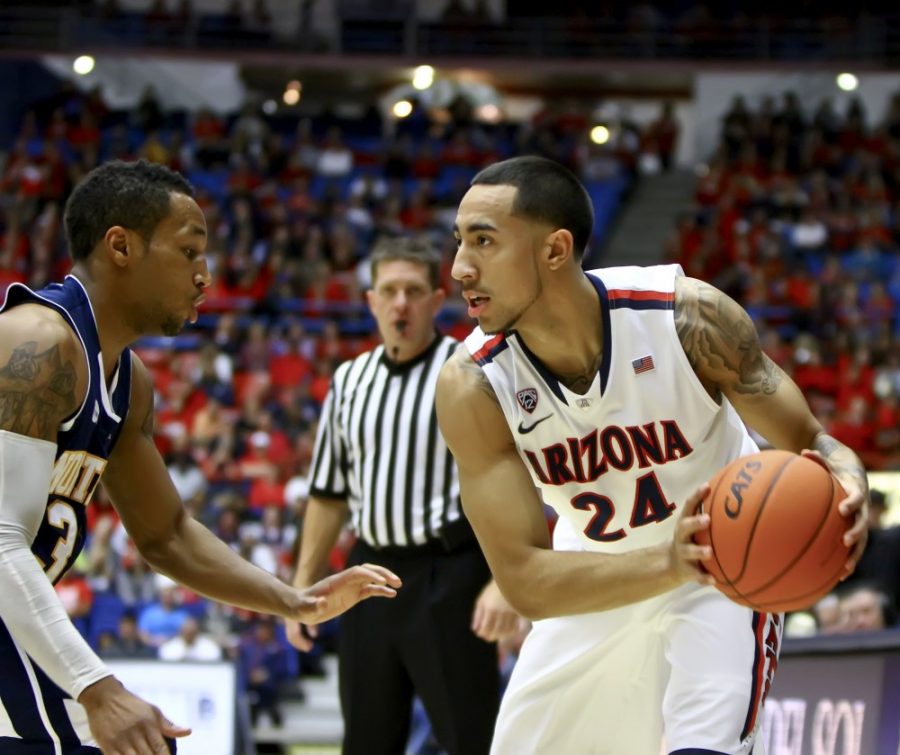Brendon Lavender was the sniper, the designated three-point shooter. In 2011-12, Lavender carved out a role as the team’s best three-point shooter, and he embraced it. In a pinch, Lavender could shoot with the best of them.
In fact, his 48.7 percent three-point shooting ranked third in the country last year. On six different occasions, Lavender came off the bench and nailed four or more shots from beyond the arc.
But now Lavender is gone.
Before last season, guard Kyle Fogg hoisted up 39,132 shots in the offseason in hopes of improving his already solid three-point jumper. He finished with the second-best percentage (44.4) on the Wildcats, and led the team with 75 made on the season.
Fogg is gone.
Now, Arizona is left without its two best long distance shooters and a roster loaded with potential fill-ins, but none that have really proven to have the range of Fogg or Lavender.
Head coach Sean Miller said that he is focused on turning the Wildcats into a team that gets to the basket and shoots a lot of free throws.
“I’ll be surprised if shooting is one of our problems,” Miller said. “We are attacking at the basket and in the paint first. The good three-point shots will come.”
Even so, the Wildcats will need someone to step up to the plate and fill Fogg and Lavender’s role, starting or on the bench, as the team’s go-to guy from beyond the arc. Here are the candidates:
Kevin Parrom
At Media Day on Oct. 10, Miller felt confident saying that Parrom might not only be the team’s best shooter now, but he was all along. Even with Fogg and Lavender in the mix.
Parrom is coming off a season where he had to deal with injuries and the death of his mother, so his numbers from last year are likely an aberration. He made 14-of-42 three-point attempts in his shortened 20-game season, after connecting on 38 three-pointers in the 2010-11 Elite Eight run and at a solid 41.8 percent clip.
Miller said that Parrom, who is entering his senior year, was probably the closest to Fogg in terms of putting up a lot of jumpers in the offseason.
“Kevin Parrom shot an inordinate amount of shots [over the summer],” Miller said. “I’m going to say maybe not as many as Kyle, but very close. He never left Tucson, so he had time on his side.”
Solomon Hill
Hill isn’t necessarily the most prolific three-point shooter for the Wildcats, in frequency or accuracy, but he showed at the end of last season that when he has the hot hand, he can be a solid shooter.
Hill made a career-high 37 shots from long range in 2011-12, and 27 of them came after Jan. 12.
“Solomon shot almost 39 percent (.389) a year ago from three,” Miller said. “He really caught fire in January and February. His shot looks really good and I think he can be consistent.”
Mark Lyons
Lyons, the senior transfer from Xavier, comes to the UA with a reputation as a shoot-first point guard, and about 35 percent of those shots came from beyond the arc last year. Lyons hit 58 three-point jumpers at a 39.2 percent clip and had 18 games where he made two or more.
Nick Johnson
The sophomore guard started off the season strongly from three, hitting 25-of-66 threes at a 37.8 percent clip in his first 19 games, nailing at least one on 12 different occasions.
The Wildcats will need more of that Johnson than the one that scored less than ten points in 12 of the last 16 games.
Jordin Mayes
As with Parrom, Mayes suffered through injuries last season and struggled after playing a key role in the UA’s Elite Eight run. In 2010-11, Mayes hit 45.3 percent of his three-pointers, including 4-of-4 in the second round of the NCAA tournament.
Last year, Mayes hit just 29 percent of his threes and had 18 games where he hit zero three-pointers. If he’s healthy, he could potentially fill the role.
Gabe York
The freshman guard is probably the least recognized of the Wildcats’ four highly touted freshman recruits, but his shooting and scoring ability has certainly caught his teammates and coach’s eye.
“Gabe is a fantastic shooter and scorer,” Lyons said.
He might be buried too deep in the guard rotation behind Lyons, Johnson, Mayes and even Parrom to make too big of an impact, but he has the ability to score from long range. In his senior year of high school, York made 55 threes in 19 games, or 2.9 per game.
Grant Jerrett
This name might come as a surprise, as Jerrett is a 6-foot-10 power forward, but if scouting reports and Miller’s word are any indication, the freshman will be a threat from deep.
“Grant Jerrett could be one of our team’s best shooters,” Miller said. “He gives us a different look when he’s in there whether he’s at the four or five because he’s a little bit like Derrick Williams.”
Jerrett made 17 threes in 27 games in his senior year of high school, nothing to write home about, but Williams wasn’t much of a shooter in high school either — he made 18 in 31 games. Before being selected as the No. 2 overall pick last year, Williams made an astounding 56.8 percent of his three-pointers in 2010-11.









